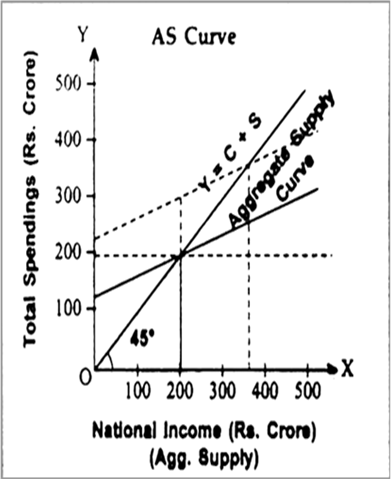State briefly the Classical Theory and the Keynesian Theory of Income and Employment.
(a) Classical Theory of Employment. The classical economists believed that:
(i) An economy as a whole always functions at the level of full employment of resources. This belief is based on Say's Law of Market that states, 'Supply creates its own demand.” which implies that supply (production) creates a matching demand for it with the result that whole of it is sold out. Therefore, there is neither overproduction nor underproduction.
Thus full employment is a normal situation and if at all there arises any unemployment, it is automatically corrected by market forces. Hence equilibrium level of income occurs at level of full employment, i.e., there is always full employment equilibrium. Therefore, Classicals advocated for a free economy.
(ii) Flexibility of prices and wages. Even if at any time there is unemployment, it must be temporary because in a free economy, flexibility of prices and wages automatically bring about full employment. Suppose at a given wage rate there is unemployment which implies that supply of labour is greater than demand for it. Competition among labour to seek employment would lead to fall in wage rate. As a result demand for labour would continue to rise until unemployment is removed from the labour market. Thus wage-price flexibility is the built-in stabiliser to ensure full employment.
The Great Depression of 1929–33. During 1929-33 there was a world-wide depression. Fall in aggregate demand was so severe that investment came down to its minimum level resulting in vast unemployment. This situation which brought great disaster to U.S.A. and other European countries fully exploded the Classical's myth that there is always tendency of full employment equilibrium. The Great Depression led to break down of Classical theory.
It was at that time that J.M. Keynes, a British Economist propounded his own theory and in 1936 brought out his famous book, 'General Theory of Employment, Interest and Money,' which brought about a revolution in economic thought. This led to emergence of Macroeconomics as a separate branch of economics.
(b) Keynesian Theory of Income and Employment. According to Keynes:
(i) An economy can be in equilibrium at less than full employment level Economic system does not ensure automatic equilibrium at full employment as believed by Classicals. There can be equilibrium (equality between aggregate demand and aggregate supply) even at less than full employment level whereas according to Classicals equilibrium is always at full employment. Thus there is divergence between the point of equilibrium attained by an economy and the point of equilibrium at which an economy has full employment of resources. This is the basic difference between Classical Theory and Keynesian Theory.
(ii) 'Demand creates its own supply' Unlike Classicals; Keynes believed that it is the demand that creates supply and not that supply creates demand. In fact, aggregate demand in the economy is the driving force that determines the level of output, employment and income. It is because the level of aggregate supply is constant during short period. If aggregate demand increases, level of output will increase to meet the increased demand. As a result, employment and income will also rise. Thus increase in demand has led to increase in output, employment and income.
This is the gist of Keynesian or Macro approach. The scope of this chapter is limited to Keynesian Theory. The core issue of macroeconomics is the determination of level of income, employment and output. According to this theory, in an economy income and employment are in equilibrium at the level at which Aggregate Demand (AD) = Aggregate Supply (AS). It needs to be noted that Keynesian theory is supposed to apply under short run and perfect competition. Since during short period supply is constant, it is because of deficiency in effective demand, which causes unemployment. So aggregate demand should be raised in order to raise level of employment. Let us, therefore, start with the meaning of aggregate demand (AD).







